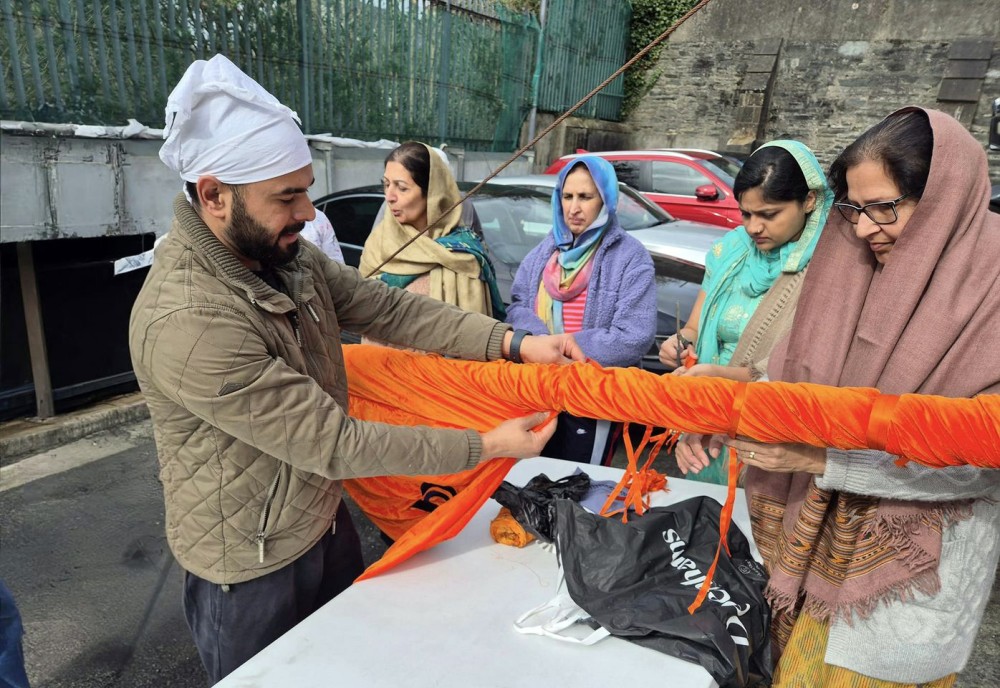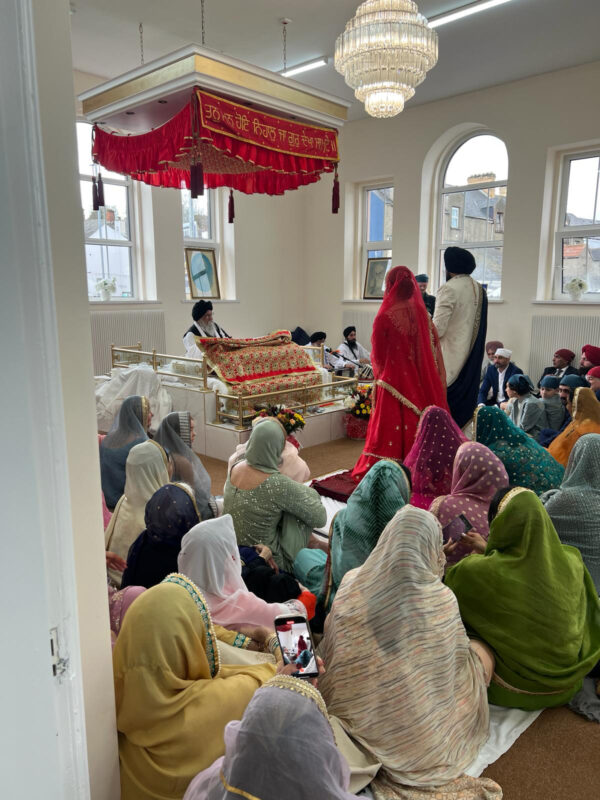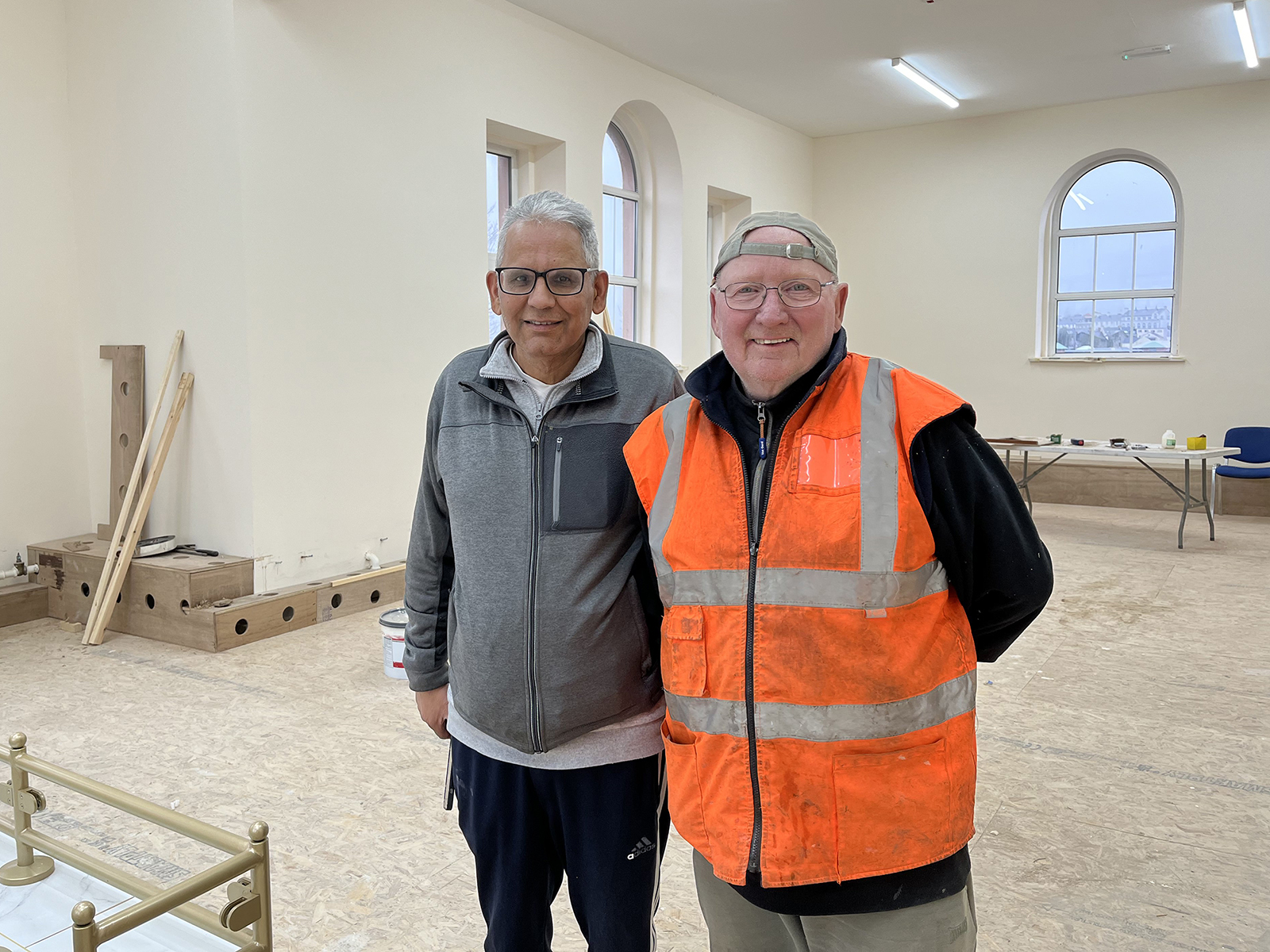In Northern Ireland, a long-awaited gurdwara opens with a wedding

A group of Derry Sikhs prepare the Nishan Sahib flag to be hoisted ahead of the reopening of the Sikh Cultural Centre in Londonderry, Northen Ireland, on March 24. (Photo courtesy of Amerjit Singh)
On a cloudy fall day in 2021, about 100 people were praying in the only Sikh temple in Londonderry, Northern Ireland, when smoke suddenly choked the prayer hall.
Worshippers covered their mouths and noses and ran outdoors as flames consumed each room. Amerjit Singh, the president of the Northern Ireland Sikh Association, made sure that everyone was safely outside before running back inside the burning building to rescue the Guru Granth Sahib, the Sikh holy scripture.
On April 11, after years of renovations—completed in the spirit of sewa, the Sikh principle of selfless service—the temple, or gurdwara, reopened with a joyful wedding celebration, welcoming worshippers of all faiths and backgrounds once again.
The multistory beige building, resting on a sloping road near the eastern bank of the River Foyle, bears a long history: An old sign indicates it was constructed in 1915, and a newer one introduces it as the Sikh Cultural Centre established in 1995. Jimmy Singh, a longtime worshipper at the gurdwara, says the reopening feels like “the light at the end of a long, long, tunnel.”
Although everyone was physically safe after the gurdwara fire, Sikhs in Derry mourned the loss of their beloved temple. The space where they convened at least once a week to pray, sing, eat, and serve each other had become a shell of a structure. The gurdwara leadership determined at the time that it would stay closed until renovations were completed.

People attend a wedding during the reopening of the Sikh Cultural Centre and gudwara in Londonerry, Northern Ireland, on April 11. (Photo courtesy of Amerjit Singh)
In the meantime, Derry’s Sikhs gathered in each others’ living rooms and kitchens to continue their weekly Sunday prayers and the tradition of langar, the free meal gurdwaras offer to any visitor without question. The gurdwara was one of two in Northern Ireland and the primary place of worship for Sikhs all over the country as well as for other minority religions, like Hindus, who don’t have a nearby temple of their own.
It was like decades ago, some recalled, when only a few Sikh families lived in Derry. In those days, they could easily gather in each other’s homes. But since then, the Sikh population in Northern Ireland has grown from a few dozen to just shy of 400, according to the 2021 Census—a number no one’s living room could fit.
“On my way to work, I always drove past and stopped for 30 seconds outside,” said Jimmy Singh of the gurdwara. The space, he said, always brought him a sense of peace and meaning, even when he couldn’t go in. “I just can’t wait to come here every Sunday,” he said.
“It’s a lifeline for older people,” said Kalbinder Kaur, a trustee of the Sikh Association. The gurdwara’s closure, she said, exacerbated the loneliness and isolation of the elderly, who found comfort in the shared language and culture of the Sikh community.
Although the Sikh community has struggled without the gurdwara, Amerjit Singh says the fire may have been a blessing in disguise. The cause of the incident has not been officially determined, but he suspects it was faulty wiring in a building that’s over a century old. The damage revealed dry rot in the walls and floors of the building that could have compromised its structural integrity. Plus, the fire was an opportunity to rebuild the gurdwara to better accommodate the needs of the community.

Amerjit Singh, left, and a volunteer at the gudwara in Londonderry, Northern, Ireland, ahead of its reopening. (Photo by Trisha Mukherjee)
About a month before the reopening, Amerjit and Jimmy Singh, who are cousins, stepped onto a brand-new elevator platform, clutching the railings.
“It’s just been commissioned today,” said Jimmy Singh with excitement. “It’s our first time using it.” He pressed a button, and a soft whirring sound filled the echoing space as the platform smoothly drifted toward the lower level. The elevator for the elderly and people with disabilities is one of the newest additions to Derry’s gurdwara.
Around them, the building buzzed with activity. Sawdust covered the floors, while ladders and tools lay scattered around the building. Volunteers from all walks of life and a number of faiths—Irish Catholic, Irish Protestant, Irish Sikh, and Indian Sikh—paced in and out of rooms, scrubbing countertops and drilling into planks of wood. A group of men, some wearing turbans and others with buzz cuts, carried building materials down the staircase and through a doorway as Irish rock music reverberated upstairs.
In a city with a long history of religious conflict, the intermingling of cultures and religions in the gurdwara epitomizes Amerjit Singh’s belief that welcoming others is the “single most important part of Sikhism.”
As he strolled around the gurdwara surveying the progress, he listed off the many people, from the architect to the construction workers, who helped rebuild the gurdwara for free or for a discount as an act of sewa.
One woman wearing heavy-duty gloves introduced herself as a former employee of his who has volunteered her afternoon to help out at the gurdwara. A carpenter measuring wood in the prayer hall said he has been doing business with the Sikh community for 30 years. Gurdeep Singh and Samser Singh, two university students from the Punjab region of India who had met for the first time that morning, spent the day at the gurdwara doing sewa, lifting heavy materials side by side as if they’d been working together for years.
Gurdeep Singh, another Sikh man from India who has lived in Ireland for several years, said he is looking forward to the prayer, the langar and, of course, the gossip. “We feel very good when we come here,” he said. “We feel relaxed.”
The community is also largely united by their support for the Sikh farmers’ protests in India.
Through Khalsa Aid, Derry’s Sikhs send money for food, clothing, and medicine for the farmers, who, they believe, are being smeared and targeted by the Indian government. The gurdwara also donates funds to local initiatives.
“Sikhs are givers,” said Jimmy Singh. “Baba Guru Nanak, the founder of Sikhism, was a giver, and we want to follow that tradition in our hearts.”
The new building is tech-savvy and accessible. While Sikhs traditionally sit on the floor for langar and prayer, the gurdwara will have benches for the elderly and others who have trouble sitting cross-legged. An expertly planned opening near the kitchen allows volunteers to easily transport groceries inside from a car, reducing the intense prep work for langar, during which volunteers serve hearty meals of daal, roti, and prasad to hundreds of people at a time. The building is more insulated and energy-efficient, critical in Northern Ireland’s soggy year-round weather. A guest room with three beds in the basement is built to host Sikh musicians and other visitors.
On March 24, about two weeks before the reopening, a group of Sikh worshippers hoisted the Nishan Sahib, a triangular orange flag with a dark-blue khanda symbol. The crowd stood barefoot around the silk-wrapped flagpole. One woman began a melodic prayer, and others closed their eyes in meditation and joined in.
A wedding seemed the perfect celebration to open the new gurdwara. Amongst traditional Punjabi music and sparkling chandeliers hanging from the newly finished ceiling, over 300 people gathered to celebrate the newlyweds—a non-Sikh Irish bride and a Sikh groom—with music, prayers and a langar of pakora, three different types of curries, gulab jamun and laddoo. Men wore suits and patkas, while women wore a rainbow of elegant salwar kameez.
“It was full of color,” said Amerjit Singh, after the daylong ceremony. “I saw a vision of a much more diverse Northern Ireland in the gurdwara today.” —Religion News Service
This story was reported as part of a study-tour in Ireland, sponsored by the Scripps Howard Foundation.



